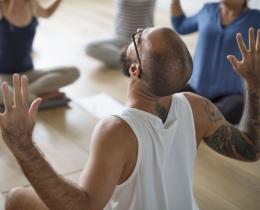Omega: How has yoga become a tool to help trauma survivors?
Sue: Ten years ago, yoga and trauma did not go together. Trauma was considered something you left to the professionals—yoga and trauma was not a widely understood pairing. Since then, emerging research, along with the continued growth of the yoga population in general, has helped yoga to become known as something helpful for at-risk populations. Trainings have become more available and more regulated. The Yoga Service Council has released three best-practices books for professionals so that yoga for at-risk populations can be better understood by yoga teachers.
Omega: How can more yoga teachers better adapt their classes to address trauma?
Sue: If yoga teachers can really educate themselves on how trauma presents itself in the body and how it can be addressed in the body, then they can offer very simple practices in their classes that can help.
Trauma-sensitive instruction gives students choices and keeps in mind that the traumatic responses are usually firing in response to times of uncertainty or the feeling of not being in control. Yoga teachers can offer students information that can minimize these reactions. For instance, at the studio I attend, teachers almost always say, “We’re heading to Warrior II and III next.” It’s a very useful and trauma-sensitive practice for a teacher to give students information in terms of what to expect and can help a traumatized system deactivate to some degree.
Omega: You have trained, inspired, and led hundreds of volunteer yoga teachers through your programs. What have you learned from these experiences?
Sue: The biggest takeaway is that everyone has some degree of trauma. For teachers to really be trauma-sensitive, they need to understand how their own version of trauma runs through their system.
Omega: Can you talk about how your work with yogaHOPE evolved into TIMBo (Trauma-Informed Mind Body) and what motivated you to create this program?
Sue: I was like every other yoga person who wanted to be of service. Yoga helped me so much I wanted to offer yoga to women who I felt didn’t necessarily have access to it. Soon into that initial incarnation of yogaHOPE, I realized that there was more to offer the women than just teaching a yoga class. The women were telling me that they really wanted connection, so I developed something where women could experience that level of connection through dialog, yoga, and meditation. What I ended up with is TIMBo, an integrative mind-body method for healing trauma.
From a business perspective, one of the driving forces for developing TIMBo was to develop something that would be replicable and scalable and that would give us some control over the quality of the program. I wanted the providers of the service to be all speaking the same language.
My personal reason for developing TIMBo was that I was going through an excruciatingly difficult time in my life where I did not know how to handle all my emotions. I wanted to develop a program that could help me understand and manage those emotions in that time of crisis and could help others do so, too.
Omega: You’ve spent much of your career researching how trauma affects the brain and the body and how yoga practices and mindfulness can help. What are the latest findings?
Sue: There’s so much research to validate what people have known for a long time about yoga and meditation practices, research that shows how these practices can quiet our thoughts, which is especially important if there is traumatic symptomology like anxiety, depression, or PTSD.
It is becoming more commonly understood that trauma is a mechanism of the sensory nervous system and the primitive brain. One of the most compelling pieces of research is that that primitive system will work in partnership with our thinking, higher-brain cognition to create a false sense of danger—or a false reality. To bring all parts of the brain back to health, you need to start by working with that primitive system.
We must develop the capacity to be aware of what’s happening in the body and use some tools that will down-regulate that system. Breath is the easiest and most accessible tool. There is a lot of research out there that deep, diaphragmatic belly breathing engages the vagus nerve, which shifts the nervous system from the sympathetic response to the parasympathetic response. The same goes for yoga and meditation.
In TIMBo one tool we offer is cognitive briefing. It's a different way of talking to your body. The key to this healing path is really being able to suspend the thoughts and cognition and even the behaviors and actions that are habitual and just be in the present moment, with awareness, and use the tools that help you stay there. You’re not fighting what’s happening or trying to change anything, but teaching your body that your life is no longer in imminent danger.
Omega: What are some considerations in adapting yoga for people who have experienced major traumas, such as being homeless or recovering from drug addiction or sexual assault?
Sue: Consider that yoga doesn’t have to be difficult. Get out of your idea of what yoga should be. It’s mindful movement, so the benefit of yoga is being mindful of where your body is in space.
I would consider accessibility, too. Everything we do in TIMBo can be done by someone in a chair—so there’s no downward dog, there’s no forward fold, and there’s no child’s pose. We’ve stripped it of anything that will be inaccessible to the women we teach and it’s also a lot shorter, about a 10-minute sequence.
Omega: Can you talk more about teaching self-compassion and empowerment through yoga to at-risk and underserved populations?
Sue: One of the foundational teachings of TIMBo is helping trauma survivors understand that there’s nothing wrong with them and that the biology of their body is wired to create a feeling of distress to keep them out of harm’s way. Having that knowledge allows many of the women we work with to be able to find the first kernel of self-compassion. We often hear women who come to our classes say, “I’m just so relieved to hear that there’s not something wrong with me and that I’m not broken.”
Omega: What advice do you have for yoga teachers who would like to become more involved in their communities?
Sue: Yoga service work can feel isolating, so I urge you to remember that you don’t have to reinvent the wheel. There are many great trainings and resources available that can provide community and support. Find your community and ask for help and resources.
Also, invest in yourself. Invest in going to the Yoga Service Conference. Invest in meeting people who are doing similar work and that can give you good advice based on experience. When you invest in yourself you’re going to be able to be present for others, which is what people who want to be of service ultimately want to do.







